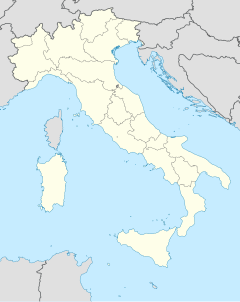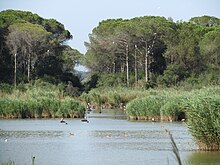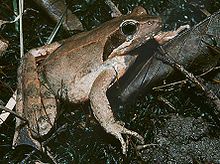Regional Park of the Delta del Po
| Regional Park of the Delta del Po | ||
|---|---|---|
|
|
||
| Location: | Veneto , Italy | |
| Next city: | Rovigo | |
| Surface: | 125.92 km² | |
The Parco regional del Delta del Po (German Regional Park of the Po Delta ) is one of the five regional parks in Italy that have been designated in the northern Italian region of Veneto ; The aim and purpose of an Italian regional park is roughly the same as that of a German nature park . It is located in the province of Rovigo and is managed by the Ente Regionale del Parco del Delta del Po Veneto . It is a UNESCO biosphere reserve .
history
About 75,000 years ago the formation of the Po Plain began during the last glacial period , the eastern edge of which on the Adriatic was between 4000 and 3000 BC. BC stabilized. This created the Po , which often shifted its course, with its extensive estuary.
Around 3000 BC The course of the river bifurcated in the plain near Reggio, creating the Po di Adria in the north and the Po di Spina in the south . But the Po di Adria was founded in the 8th century BC. Moved by a flood, so that it now flowed over Calto and Stellata and then united with the Po di Spina. In the 6th and 5th centuries BC Two new arms emerged below Ferrara , the Olana (later Volano) and the Padoa (from which the name of the Po goes back), which was known as Eridano in ancient times . The Olana, from which the Gaurus (Goro) branched off, divided at Mesola . In Roman times new arms emerged around Comacchio , while the city of Adria was located in a gulf. In the 6./7. In the 17th century AD, the Po di Spina disappeared, the marshland around Comacchio expanded, with the Po di Volano in the north and the Po di Primaro in the south. Ferrara was formed where the river split. As a result of the renovation work by the Benedictines of Pomposa Abbey and the subsoil subsoil, salt water penetrated the marshland. In 1152 the delta expanded northwards as a result of enormous flooding, and Ficarolo was destroyed. This expansion to the north continued in the late Middle Ages . The northern arms widened, which reduced the amount of water in the Po di Primaro and in the Volano. Although the Estonians tried to stop the silting up of the Po di Ferrara by diverting the Reno into the old river bed, the process could only be delayed. The northern movement also made further progress and new branches of the river such as the Ramo di Tramontana, the Ramo di Levante and the Ramo di Scirocco emerged. With its sediments, the Po di Tramontana reduced the water depth towards Chioggia .
Concerned about further northern expansion, which would have silted up the lagoon of Venice , the river was diverted southwards towards Sacca di Goro by an artificial bed in which the river still flows today. This early 17th century intervention is known as the Taglio di Porto Viro . It led to the creation of the delta as we know it today. The old river bed became a navigable canal, the Canal Bianco-Po di Levante. While the delta had expanded 53 hectares each year prior to 1600 , that rate now increased to 135 hectares from 1604 to 1840.
After 1604, new silting areas were constantly emerging. They were called le Marine and sold as land. These "vendite di onde in mare" (buying waves in the sea) have always been extremely endangered. There was salt recovered, but gradually also farmland came of it. The lords left the land to their tenants to use, on which the large Venetian villas were soon to be built. This is how the Tiepolo, Farsetti and Dolfin palazzi came into being, and the names of these places still bear today.
In the 19th century the Sacca di Goro filled up, the Isola di Ariano lengthened and the Sacca di Scardovari was created. Frequent flooding made agricultural machinery difficult to use, so the dams were raised as part of the Baccarini Act of 1882, which guaranteed state funding for land reclamation. The Isola di Ariano was drained by means of a suction pump from Ca 'Vendramin in order to open up the area of large-scale tillage.
In the 1940s methane deposits were discovered , the development of which led to the subsoil sinking by more than 3.5 m below sea level. The inadequate handling of fresh water also led to further subsidence, so that large areas of land that had already been reclaimed were lost again. In 1951 the highest level of flooding was reached, the entire Polesine to Occhiobello flooded.
Today the delta is below sea level, apart from the dams, sandbanks and fossil dunes. The Consorzio di Bonifica Delta Po-Adige has large quantities of water sucked off, with one billion m³ of water being pumped into the drainage channels every year.
In September 2013, the request was for acceptance as a biosphere reserve in the UNESCO submitted.
flora
In this complex cultural landscape, a distinction is made between different types of landscape, such as the areas of the old river beds, the fossil dunes, the dams, the flood beds (golene), the Valli da pesca , the lagoons, Sacche and Scanni.
Only small stocks of the autochthonous forests that existed until the 1950s have remained. In the drier areas, such as the younger dunes, the holm oak ( Quercus ilex ) predominates. In the depressions between the dunes, where the water lingers for a long time, especially in winter, the narrow-leaved ash (Fraxinus oxycarpa) predominates, then the silver poplar ( Populus alba ) and the field elm ( Ulmus minor ). Further to the west, on the older dunes, there are English oak ( Quercus robur ) and hornbeam ( Carpinus betulus ). On the dune ridges, the so-called staggi, there are predominantly silver poplars, silver willows ( Salix alba ) and ash trees.
Pine forests , however, were only registered later; these are mainly Italian stone pine Pinus pinea and maritime pines ( Pinus pinaster ). In addition, stone and summer oaks also grow under which numerous types of bushes and orchids thrive.
In the moist fresh water zones, in pools, cut-off river arms, canals, abandoned construction pits and the newly created wetlands along the coast, there is rich swamp vegetation. There you can find willows and poplars. On dykes, banks and flood beds are dense stocks of bank sedges ( Carex riparia ), bindweed ( Calystegia sepium ) or swan flower ( Butomus umbellatus ) as well as some rare orchid species. In spring, the yellow of the iris ( Iris pseudacorus ) dominates.
In the areas with low water levels, reed ( Phragmites australis ) thrives, which is often associated with the narrow-leaved cattail ( Typha angustifolia ) or the rush edge (Cladium mariscus). In the areas with deeper water there is the common pond rush ( Schoenoplectus lacustris ), where the water is more than half a meter deep, the white water lily ( Nymphaea alba ) and the yellow pond rose ( Nuphar luteum ) grow . In addition, there are various species of the thousand leaf , horn leaf or species such as the European frog bite ( Hydrocharis morsus-ranae ), usually referred to only as a frog bite, small duckweed ( Lemna minor ), water nut ( Trapa natans ), which is threatened with extinction in Germany, or the European sea jug ( Nymphoides peltata ).
In the areas that are heavily dominated by salt water, the vegetation differs considerably. In the so-called Valli da pesca , the most common type is the beach balm ( Ruppia maritima ) from the genus of balances . But sea lettuce ( Ulva lactuca ) can also be so dense that it makes it impossible for boats to pass through. Where the salinity of the water is less high, however, the reed ( Phragmites australis ) known as “canna di palude” prevails in association with the sea-beach rush ( Juncus maritimus ).
At the edges of the Barene , a form of salt marshes that is typical here and for the Venetian lagoon, the lower silt grass ( Spartina maritima ) dominates, which only occurs in the northeast in Italy, and the Spartina juncea or patens , which is also a silt grass . With increasing salt content, other plants are found, such as the endemic to the brackish water zone , the samphire species Salicornia veneta , or various species from the Arthrocnemum family from the Chenopodiaceae family , which belongs to the carnation-like order . These include Arthrocnemum fruticosum , perenne and Arthrocnemum glaucum . The foxtail family , on the other hand, includes the beach sod and the wire-haired Dornmelde .
The French tamarisk ( Tamarix gallica ) known as "tamerice" is one of the few trees that can exist here, with a height of 2 to 4 m. Among the protected species, the sea lavender , but also the salt elephant and the beach aster, contribute to the richness of color in the region .
In the drier, higher-lying areas, the flora of the near-ocean biotopes differs from that of the more remote biotopes. European sea mustard (Cakile maritima), Italian pointed burdock ( Xanthium italicum ) and sea thistle ( Eryngium maritimum ) thrive on the dunes near the Adriatic Sea . In addition, there is the rush mercury ( Agropyron junceum ), the Italian straw flower ( Helichrysum italicum ), the dune sedge ( Cyperus kalli or capitatus ). Sea snail ( Medicago marina ) from the large legume family also grows here .
Common beach grass ( Ammophila littoralis or Ammophila arenaria ) grows in the higher areas of the dunes ; where the dune crest has stabilized over a long period of time, mosses settle, such as the roof toothed moss ( Tortula ruralis ), often in connection with Scabiosa argentea from the genus of the scabiosis or Vulpia membranacea .
Further inland you can find pointed-leaved asparagus ( Asparagus acutifolius ), Phyllirea angustifolia , but also sea buckthorn , common juniper and the common thistle thrive here.
fauna
The habitable space for ground dwellers is naturally limited, but over 370 species of birds, as well as numerous fish and mollusks, live here.
Are widespread heron species such as the gray , night and egrets , as well as the purple and Rallenreiher , as well as grebes , cormorants , marsh harrier and bittern , bearded tit and various passerines . In addition there are the reed warbler , reed warbler , silk warbler , black tern and the whitebeard tern , which is very rarely seen . In reserve nest dwarf and common tern , laughter and sandwich tern , silver and black-headed gull , but also redshank , black-winged stilts and avocets as Loeffler , Glossy Ibis , Common Goldeneye and shelduck .
Thousands of coots and numerous species of ducks come here in winter , such as diving ducks , tufted ducks or pochard , but also mallards , pintail , pintail , spoonbills and wigeons .
In the area of the deepest waters there are avocets , stilt-walkers , in winter also snipe and black-tailed godwit . The oystercatcher , which has almost disappeared in the rest of Italy, breeds on the beaches and on the sandbanks .
At mollusks especially the edible mussels (see Mytilus galloprovincialis ), only here Cozza di Scardovari called, European and the Portuguese oyster ( Crassostrea angulata ), the Ensis ensis and the gridded clam ( Ruditapes decussatus ) from the family of clams . Of considerable economic importance is the kind Venerupis decussata herein as verace vongola is known and belongs to the family of clams. The Filipino clam (Tapes philippinarum) has spread widely in the entire area of the Venetian lagoon, in the Adige and in the Po di Goro since the 1970s . This spread is due to the strong demand, so that there were violent disputes here.
The most common fish species are pike , carp , tench , sunfish and the black pygmy catfish, originally from North America . Red mullets live in the muddy shoreline , but also various species of sole , flounder and flatfish . The sturgeon still existing in the Adriatic have almost disappeared, as has the noble crayfish , while the European catfish , which was introduced through artificial breeding, is spreading rapidly.
In the Valli da pesca, European sea bass (or spotted sea bass , both known as branzini ), then sea bream , mullet (Cefalo del Polesine) and eels are used. Gobies , more precisely the Anguilla del Delta del Po, which migrate to the Adriatic to reproduce and then return, and atherina live in the more salty water . The female Anguille grow to be up to 1.5 m long and weigh up to 6 kg, while the males remain much smaller.
Among the reptiles and amphibians, the European pond turtle is typical of the reserve, and the agile frog is also common . The Italian agile frog, on the other hand, is rare . The North American bullfrog also comes from North America . The pond frog lives in the areas with trees , and various tree frog species are also common .
The only colony of the common spadefoot can be seen in the botanical garden of Caleri . The common toad and the smaller green toad live in the wooded areas and survive in salty water.
Very shy, up to 1.5 m long real otters (vipera) are only found in the few forest areas and the pine forests near the coast. In the area of watercourses living grass snake and the smaller dice snake .
Some mammal species also live in the park area, including hedgehogs, moles, and mice. Mention should be made of shrews, including the swamp shrew, the Eurasian harvest mouse , the Eastern water vole and the great vole. Then there are nutria and fox .
Web links
- Park website (ital.)
- Pescato del Delta del Po , Provincia di Rovigo
Remarks
- ↑ POACEAE: Agropyron (wheat grass) , website of the University of Hamburg.
- ^ Cefalo del Polesine .










